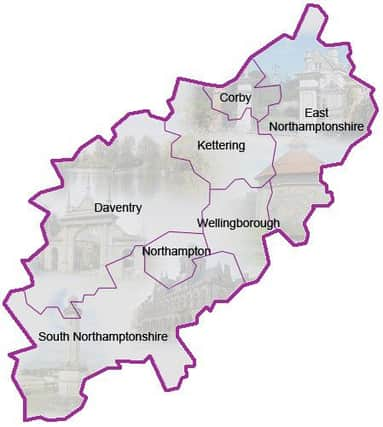Northamptonshire folk say it is time councils joined services to save money amid massive public service cuts


On December 8, county finance chiefs announced one of the most drastic set of cuts in the history of the authority.
The draft proposals place 343 jobs at risk and will look to strip £1.3 million from the Northants Fire and Rescue budget, axe the Nourish school meals service, shut two care homes and save around £27 million in adult social care services.
Advertisement
Hide AdAdvertisement
Hide AdAfter the plans were announced, councillors from the UKIP and Liberal Democrat benches renewed calls for the council to combine with district authorities in the county to create one over arching unitary authority, which some have claimed would save the public purse £70 million a year.
Many feel millions are wasted each year through duplicated services. In one example districts and boroughs currently collect waste, but the county council is then in charge of disposing of it at recycling centres.
And the early results from the county council’s cuts consultation show the public feel the same way too.
One question in the consultation form reads: “To what extent do you agree that it would be a positive development for the county council to move towards a combined authority?”
Advertisement
Hide AdAdvertisement
Hide AdIn the first week 70 people responded to the question, with 68 per cent either agreeing or strongly agreeing the council should work more closely with the surrounding districts and boroughs.
But some of the respondents comments were more telling, with many saying the councils should join up to create one unitary authority.
“A unitary authority is so obvious and necessary,” said one. “If this lays the groundwork, good.”
Another said: “Fewer organisations should mean less red tape and more coordination.
Advertisement
Hide AdAdvertisement
Hide AdAnd another said: “I agree that combining some of the functions which are currently carried out by borough and district councils would provide savings, efficiencies and a better standard of customer service.”
Not everyone likes the idea of joining up the seven district councils in Northamptonshire with the county council.
One respondent wrote: “Because when I want to talk about local issues, I expect a local person to respond, not someone in a far off town.”
But Councillor Michael Brown, (UKIP, Kingsthorpe North) says the early consultation results show there is support for calls to set up a unitary.
Advertisement
Hide AdAdvertisement
Hide AdHe said: “It would cost money to do yes, but if we get our act together, we could do it from an invest to save point of view.
“Every year this council would be £70 million better off, it’s such an obvious thing to do.”
Leader of the council, Councillor Jim Harker (Con, ISE), says that Northamptonshire would struggle to find the government funding to set up a unitary authority, as it is “just not on the agenda in Parliament”.
But he said “devolution” is very much on the agenda and the county council will be looking at a number of ways to work with the district councils and neighbouring counties such as Cambridgeshire and Buckinghamshire, to save money in the coming years.
Advertisement
Hide AdAdvertisement
Hide AdHe said: “It is easy to see just how much efficiency could be realised by bringing together such work. One waste collection contract instead of five separate ones would in itself save millions.
“I will now be speaking to the leaders of the districts and boroughs about how we might formalise our working relationships between all of our councils to deliver services in a far more integrated manner through looking at the combined authority model which could help us all deliver the savings we need to and in a way which would create more consistent services to the public.”